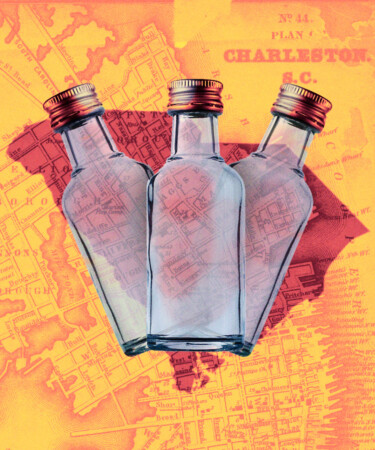For many of us, mini liquor bottles are a novelty encountered most often in the context of mid-flight meal service or in-room hotel minibars. It’s not often that you’ll find one in a brick-and-mortar bar — unless they’ve been snuck in for some inconspicuous consumption. But in early aughts South Carolina, it wasn’t uncommon to spot hundreds of little nippers while out for a nightcap. In fact, until 2006, mini bottles were the only liquor bottles you would find behind the bar at a watering hole or restaurant across the Palmetto State.
Following Prohibition, it was illegal for bars and restaurants in the state to serve their own liquor, so South Carolina drinkers were required to bring their own booze to their night-out destination and purchase mixers and ice to make their own drinks when they got there. In an effort to crack down on the amount of this brown-bagging, South Carolina’s mini bottle law, which was in effect from 1973 to Jan. 1, 2006, mandated that every single alcoholic drink served in the state must be made with alcohol poured from a 1.7-ounce, sealed mini bottle.
Those in favor of the mini bottle legislation argued that it would assure quality for consumers and reduce public intoxication — as any restaurant or bar guest would be required to finish their drink before departing — in addition to providing the state with considerable tax revenue. And at the time, it actually wasn’t unheard of for state legislatures to restrict on-premise liquor sales to mini bottles — Texas and Utah both had similar laws. What was unusual, however, was just how long South Carolina’s stayed in effect. Where both Texas and Utah overturned their minis-only rules in 1990, South Carolina’s law would inhibit drinkers for 33 years.
As a result, the state’s cocktail culture was stymied, as bartenders were relegated exclusively to liquor brands sold in mini bottles. While this doesn’t seem like a huge deal for those ordering Vodka Sodas or Gin & Tonics, mixed drinks like the Long Island Iced Tea or the Negroni became incredibly expensive or downright impossible to produce. Time became an obstacle, too. As shots could only be served from minis as well, ordering them became increasingly complicated. When a guest ordered shots, bartenders were required to ask how many ways the 1.7-ounce mini bottle would be split: “one two ways,” meaning one bottle would be split into two glasses, or “two three ways,” meaning two bottles in three glasses. The system, foreign to out-of-state visitors, often clogged up already-crowded bar lines as bartenders had to manually open each and every mini bottle during service.
While the mini bottle law certainly came with its faults, there were a number of benefits for bar-goers. They could be assured the liquor they ordered was the liquor they actually received, and with 1.7 ounces of alcohol in each mini bottle, a single drink in South Carolina was almost twice as strong as those free-poured at around 1 ounce elsewhere in the country.
But with the obscene cost of cocktails rising and the obvious hindrance to any meaningful contributions to the cocktail world, residents knew something had to change. That’s why in the November 2004 general election, the majority of South Carolinians voted to do away with the mini bottle legislation on the basis that free-poured alcohol would make drinks cheaper and reduce the number of alcohol-related traffic accidents, as less alcohol would be present in each drink. The 41 percent of voters who opposed the overturning of the law argued that switching to free-poured drinks would allow for bartenders to water down cocktails and reduce tax revenue. The latter were outnumbered, and South Carolina could finally legalize free-poured alcoholic beverages from standard-sized liquor bottles.
The switch did not come without its hurdles, though, as mixologists who had never worked outside South Carolina’s borders had to learn how to properly measure and mix drinks using the new system. If that wasn’t enough, the back bars at bars and restaurants statewide all had to be redesigned to accommodate 750-milliliter bottles, having previously been designed to house innumerable minis.
Despite the hiccups that may have resulted from the legislation’s overturning, South Carolina’s move to free-pouring liquor has allowed for cocktail culture in the state to thrive. Now, Charleston is on its way to cementing itself as one of the best cities in America to drink in.
